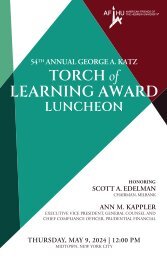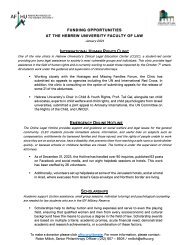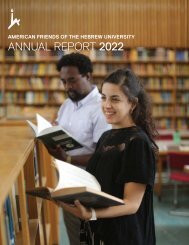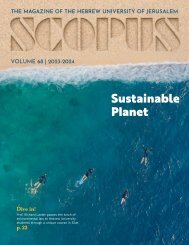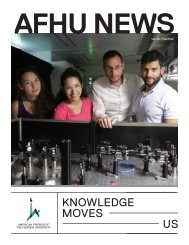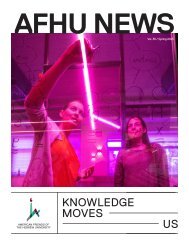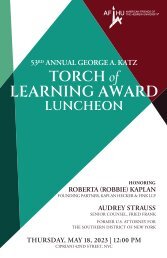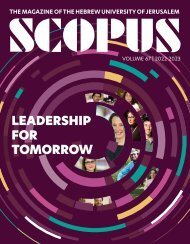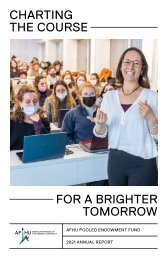Create successful ePaper yourself
Turn your PDF publications into a flip-book with our unique Google optimized e-Paper software.
prestigious NIH Research Scientist Career Award and an<br />
ERC Starting Grant — and he cites his multidisciplinary<br />
team of physicists, engineers, biologists and doctors as<br />
crucial to the advancement of the project. And looking ahead,<br />
says Nahmias, the human-on-a-chip tool will allow him to<br />
rapidly test the drugs that he discovers in his laboratory.<br />
“It’s a vision for the next decade.”<br />
Yossi Zamir<br />
Modifying for Malaria<br />
Prof. Alexander Vainstein of the Robert H. Smith<br />
Institute of Plant Sciences and Genetics in Agriculture<br />
in the Robert H. Smith Faculty of Agriculture, Food and<br />
Environment never thought he’d be doing work with major<br />
implications for treating malaria. But through a circuitous<br />
turn of events, Vainstein — head of one of the world’s<br />
top laboratories for creating genetically modified plants<br />
Learning Processes<br />
When Yael Mandelblat-Cerf was a teenager,<br />
Mandelblat-Cerf designed clever<br />
brain chemical known to be related to<br />
she went on a class trip to a nearby university<br />
experiments requiring subjects to dynamically<br />
rewards and expectation — as<br />
for lectures about the brain. She sat,<br />
learn new tasks in a changing environment. On<br />
songbirds learn to sing.<br />
enraptured, as neuroscientists discussed the<br />
examining the responses of their individual<br />
“My hypothesis is that dopamine is<br />
marvels of the mind. “Afterwards, I told my<br />
brain cells, she was able to identify two groups<br />
not just related to rewards and<br />
friends that I was going to be a<br />
of cells: the activity of one group correlated<br />
expectation, but that it can promote<br />
neuroscientist,” she reminisces. “They<br />
with fast learning, and the other with slower<br />
learning in a specific direction,” says<br />
laughed but the idea stuck in my head.”<br />
learning. The experiments answered the<br />
Mandelblat-Cerf.<br />
Mandelblat-Cerf did go on to become a<br />
question as to why fast learning is forgotten<br />
She is using advanced tools to<br />
neuroscientist. In late 2010 she completed<br />
her doctorate in neuroscience in the Hebrew<br />
University’s Faculty of Medicine. Today, she<br />
is a postdoctoral fellow at MIT, where her<br />
position is supported by a partial fellowship<br />
from the Hebrew University’s Edmond and<br />
faster, and showed that the two neuronal<br />
processes ensure good performance while<br />
remaining flexible in order to accommodate<br />
new changes in the environment.<br />
“Although my doctoral research doesn’t<br />
have direct medical applications, I think it is<br />
study how what the bird hears affects<br />
the response of its dopamine cells, and how<br />
these dopamine cells in turn affect motor<br />
areas of the bird’s brain, which ultimately<br />
control the bird’s singing ability.<br />
Following her fellowship at MIT,<br />
Postdoctoral<br />
fellow Yael<br />
Mandelblat-Cerf<br />
hopes to study<br />
Alzheimer’s<br />
disease on her<br />
return to Israel<br />
Lily Safra Center for Brain Sciences (ELSC).<br />
important — even necessary — to<br />
Mandelblat-Cerf plans to return to Israel.<br />
During her doctoral studies, Mandelblat-<br />
understand the neural basis of sensorimotor<br />
Ideally, she’d like to set up her own lab and<br />
Cerf worked with ELSC Director and member of<br />
learning for treating motor neuron diseases,”<br />
eventually study Alzheimer’s disease, which<br />
the Faculty of Medicine Prof. Eilon Vaadia to<br />
Mandelblat-Cerf says. “Gaining an<br />
runs in her family. Presently, most<br />
disentangle the various components of<br />
understanding of how the brain facilitates<br />
Alzheimer’s research focuses on the<br />
sensorimotor learning. It had long been<br />
movement and consolidates learning will<br />
molecular level, but Mandelblat-Cerf<br />
observed that two main processes underlie<br />
help enable the development of future<br />
envisions approaching the problem from her<br />
learning: a “fast learning” process, where skills<br />
devices and medications.”<br />
level of expertise, which is studying neuron<br />
are picked up quickly but also forgotten<br />
At MIT, Mandelblat-Cerf is working with<br />
populations and the connectivity between<br />
quickly, and a “slow learning” process, whereby<br />
neuroscientist Prof. Michael Fee and is<br />
different brain regions. “Current drugs<br />
skills are learned slowly but retained for longer<br />
continuing to investigate brain mechanisms<br />
mostly postpone deterioration,” she says,<br />
periods. No one, however, had investigated the<br />
underlying sensorimotor learning. This time,<br />
“but my dream would be to find a way to<br />
neuronal basis for these two processes.<br />
she is studying the role of dopamine — a<br />
prevent Alzheimer’s.”<br />
<strong>2012</strong>/<strong>2013</strong><br />
21




